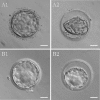In vitro and in vivo viability of human blastocysts collapsed by laser pulse or osmotic shock prior to vitrification
- PMID: 21152966
- PMCID: PMC3114962
- DOI: 10.1007/s10815-010-9522-4
In vitro and in vivo viability of human blastocysts collapsed by laser pulse or osmotic shock prior to vitrification
Abstract
Purpose: This study was designed to investigate whether artificial shrinkage, induced by a laser pulse or hyperosmotic sucrose solutions, improves in vitro survival and/or implantation of vitrified-warmed human expanded blastocysts.
Methods: Before Cryotop vitrification, the blastocoelic cavity was collapsed either by a laser pulse or sucrose solutions. Non-treated blastocysts were used as control. Post-warm blastocyst survival and implantation after transfer were examined. Implantation rate outcome was retrospectively analyzed by morphological grading and developmental kinetics of post-warm blastocysts.
Results: Survival rates in the three groups were high. Implantation rates in the laser-pulse group (59.7%) were comparable with those in the sucrose group (49.3%), and were significantly higher than those in the control group (34.2%). The proportion of blastocysts showing fast development tended to be higher when the blastocysts underwent artificial shrinkage treatment before vitrification. There was no clear correlation between morphology of post-warm blastocysts and implantation rate.
Conclusion: Artificial shrinkage treatment before vitrification is associated with an increased probability of fast-developing embryos, resulting in higher implantation rates.
Figures


References
-
- Zeilmaker GH, Alberda AT, Gent I, Rijkmans CM, Drogendijk AC. Two pregnancies following transfer of intact frozen-thawed embryos. Fertil Steril. 1984;42:293–296. - PubMed
-
- Gardner DK, Lane M. Culture of viable human blastocysts in defined sequential serum-free media. Hum Reprod. 1998;13(Suppl 3):148–159. - PubMed
-
- Ménézo Y, Nicollet B, Herbaut N, André D. Freezing cocultured human blastocysts. Fertil Steril. 1992;58:977–980. - PubMed
Publication types
MeSH terms
Substances
LinkOut - more resources
Full Text Sources
Medical

